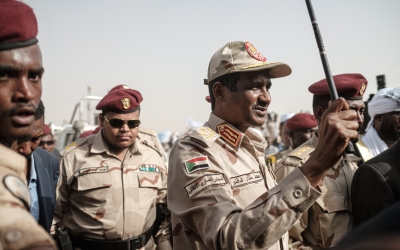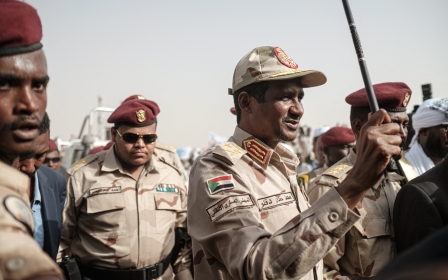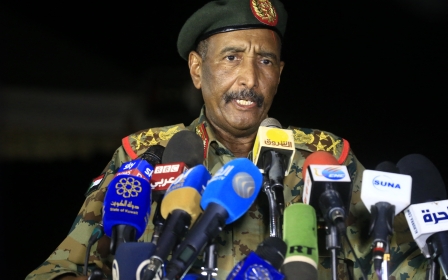Sudan: The protester who had his leg shot off
When 19-year-old Mohayad Faisal Gaafar and his comrades from the resistance committees of the Aljeraif and Burri neighbourhoods of Khartoum saw a convoy from the Sudanese Armed Forces in military uniform, they tried to escape.
But the soldiers promised to protect them, saying they would lead the young protesters close to the army headquarters.
New MEE newsletter: Jerusalem Dispatch
Sign up to get the latest insights and analysis on Israel-Palestine, alongside Turkey Unpacked and other MEE newsletters
It was 25 October. This demonstration in Sudan’s capital, made up of hundreds of young men and women, felt safe and comfortable. Protesters remembered the sit-in of April 2019 in front of army headquarters, when part of the military had protected them.
Junior officers in the army - particularly in the tanks division - were known to be on the side of the people.
“We thought they were protecting us and that they would stand with us,” said Mohayad and his twin brother Moayad. “We soon realised they were dragging us into a bloody mess.”
The day ended with Mohayad needing to have his leg amputated after having been shot twice.
Against the coup
More than 40 protesters have been killed during protests that erupted in Sudan following the military coup of 25 October.
On 21 November, military chief and de facto head of state General Abdel Fattah al-Burhan cut a deal with Abdalla Hamdok to reinstate the civilian leader as prime minister, infuriating protesters who previously backed Hamdok.
'We thought they were protecting us and that they would stand with us. We soon realised they were dragging us into a bloody mess'
- Mohayad Faisal Gaafar, protester
The prime minister had been placed under house arrest following the coup, with other civilian ministers and members of the Forces for Freedom and Change (FFC) coalition also arrested.
Mohayad, a first-year student in the engineering faculty at the University of Khartoum, is a member of the grassroots resistance committee in his district.
As informal community networks, the committees are loosely affiliated with the FFC and have been at the forefront of efforts to power Sudan’s transition to democracy.
After news of the 25 October coup broke, Mohayad came out onto the street. It was early morning.
“We came out to 60th street in Khartoum from the neighbourhoods around and we heard that our colleagues in other areas like Burri, Eastern Nile, al-Kalakla and others were all on the streets, so we began organising the people and moved towards Burri, near the army headquarters,” he said.
“When we were about to reach the headquarters, we saw a convoy of army vehicles and soldiers with military uniforms. We were scared and tried to escape, but they were asking us to come close to the headquarters and they dealt with us in a good manner, so we thought they were on our side. But the situation changed very quickly.”
Protesters surrounded and shot
Mohayad told MEE that once the group got close to the square where the army headquarters are located, the accompanying soldiers suddenly became very aggressive and started to fire their weapons.
“They led us to the square near the army headquarters, crossing the checkpoints put up by the army, allowing us in,” Mohayad said. “Then they started shooting randomly and a number of us were immediately injured.”
The group ran as fast as they could, but the soldiers tracked them to the Burri neighbourhood close to the headquarters and blockaded them in from all directions.
“They continued shooting. I saw two people die and others were injured,” the 19-year-old said. For two hours, the resistance committee remained under intense fire, meaning they couldn’t take their injured members to hospital.
'My leg is a small gift to the Sudanese people and to everyone who loves democracy'
- Mohayad Faisal Gafaar
“No ambulances could get in, so we used a motorbike to open a small corridor through the narrow roads inside Burri to transport the injured one by one. Someone opened her house to us to evacuate the injured and take them to hospital. The soldiers followed us there, knocking on the door and trying to attack us. They failed to get inside, though.”
It was around this time that Mohayad’s twin brother, Moayad, noticed something. As they lay on the ground trying to avoid the shooting, he realised his brother was injured and that he had been shot.
“Mohayad was injured because he was trying to evacuate those who had been hurt. He had been shot twice - two bullets in the leg. I took him inside the secure house and waited for the motorbike to take him to the hospital. It was a painful moment, to see your twin brother bleeding,” Moayad told MEE.
Two other sources present confirmed the incident, describing it as a case of army soldiers shooting with the intent to kill. The sources, who requested anonymity for security reasons, said they would keep protesting against the coup and call for the prosecution of its perpetrators.
Amputation
A few days after the shooting, Mohayad had his leg amputated.
“I’m waiting for the doctors to give me an artificial leg, so I can join my colleagues on the streets again,” he told MEE. “My leg is a small gift to the Sudanese people and to everyone who loves democracy. It is a small sacrifice when compared to those who have lost their lives.”
The twins' mother Nadia Bashir said that she is worried about her son’s health. She called for her son’s attackers to be brought to justice.
“It’s painful to see your son in this situation, as his leg has been amputated and he is still very young," she told MEE.
"He will continue his life with an artificial one, but I thank God for everything in the end, and I say to him: stand with the people with your rights, whatever the cost.”
Mohayad is not the only victim of the violence of the police, army and associated militias, including the Rapid Support Forces (RSF), led by the powerful general, Mohamed Hamdan Dagalo, widely known as Hemeti.
The Central Committee of the Sudanese Doctors (CCSD) and the health ministry confirmed that at least 40 protesters have been killed since the 25 October coup. The CCSD further said that the authorities have attacked hospitals in different parts of Khartoum.
Police and army issue denials
The Khartoum police have denied its forces have been involved in the violence or in any illegal actions, saying that the protests became violent and subsequently forced the police to intervene.
More than 50 officers have been injured during the protests following 25 October, the police said in two separate statements.
“The protests began peacefully but suddenly changed, becoming violent and pushing the police into using the minimum amount of force to stop it, so we only used tear gas and we don’t know where the reports about using live ammunition come from,” Khartoum police said in a statement.
Speaking on condition of anonymity, a police source said protesters had set fire to a police vehicle in the Station 7 area of Khartoum on 13 November.
But a protester from the same area has denied this, saying that the police intentionally burned the vehicle in order to give themselves an excuse for the violence they planned to inflict on protesters.
The army has also denied its involvement in violence against protesters. An army spokesman contacted by MEE did not respond to questions.
Middle East Eye delivers independent and unrivalled coverage and analysis of the Middle East, North Africa and beyond. To learn more about republishing this content and the associated fees, please fill out this form. More about MEE can be found here.








